24th Annual Pathology Research Symposium a Resounding Success
By Lynn McCain | November 14The 24th Annual Pathology Research Symposium, held on Friday, November 7th, was a resounding success! The auditorium was filled with graduate students, faculty mentors, and others interested in learning more about the exceptional work being performed by our students.
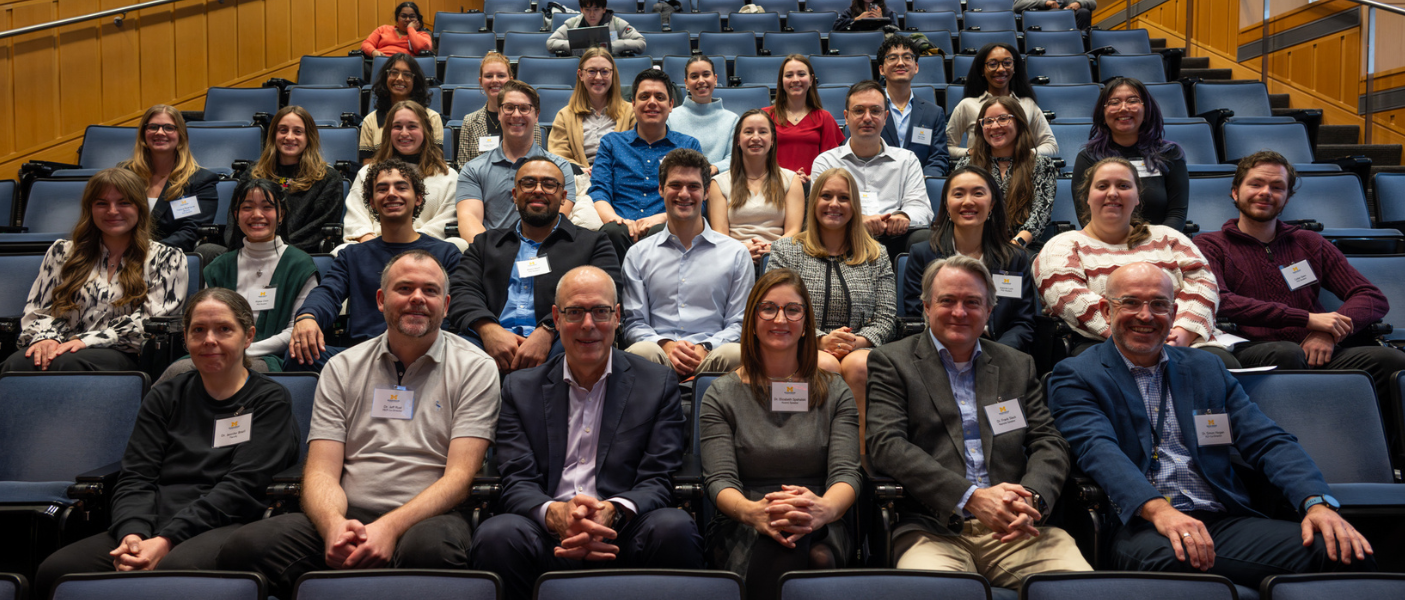
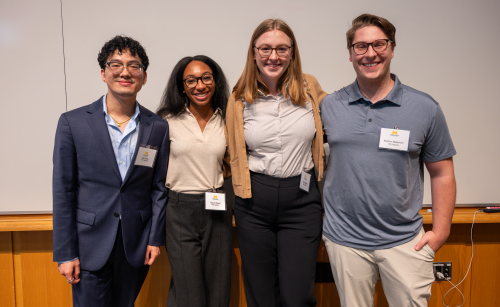 The morning kicked off with a warm welcome from MCP 3rd year students, Paula Reichel and Bretton Badenoch, who welcomed everyone to the symposium. Program Directors Drs. Simon Hogan and Jeff Rual then welcomed the audience before handing the microphone to Pathology Chair Dr. Charles Parkos. Parkos introduced our special guest, Dr. David Miller, CEO of Michigan Medicine and Executive Vice President for Medical Affairs. Miller’s clinical focus is treating prostate cancer patients, and he discussed the impact that digital pathology and molecular and cellular pathology are having on patients at Michigan Medicine, as well as how the research conducted by students is incredibly connected to patient care.
The morning kicked off with a warm welcome from MCP 3rd year students, Paula Reichel and Bretton Badenoch, who welcomed everyone to the symposium. Program Directors Drs. Simon Hogan and Jeff Rual then welcomed the audience before handing the microphone to Pathology Chair Dr. Charles Parkos. Parkos introduced our special guest, Dr. David Miller, CEO of Michigan Medicine and Executive Vice President for Medical Affairs. Miller’s clinical focus is treating prostate cancer patients, and he discussed the impact that digital pathology and molecular and cellular pathology are having on patients at Michigan Medicine, as well as how the research conducted by students is incredibly connected to patient care.
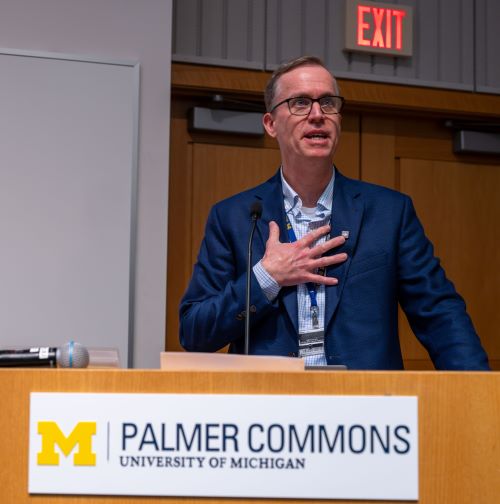 “I visited the posters of Grace [McIntyre], Joanna [Lum], and Ismael [Cabrera Silva]. You are doing incredible work with immediate relevance to our academic health system,” praised Miller. He discussed McIntyre’s research on mRNA therapeutics for ovarian cancer, Lum's poster on mechanistic factors that unlock and suppress tumor growth, and Cabrera Silva’s research on epithelial crypts in the colon that could translate into better life for Michigan Medicine patients. “This is the next generation of science, as we bring innovations forward to as many communities as we can. Training programs depend on resources. The cores are excellent, and collaborative opportunities are strong. Excellent mentorship is essential. Finally, excellent students are evident, as demonstrated by the interactions I have had. I’m grateful to spend some time with you today. Thank you and Go Blue!”
“I visited the posters of Grace [McIntyre], Joanna [Lum], and Ismael [Cabrera Silva]. You are doing incredible work with immediate relevance to our academic health system,” praised Miller. He discussed McIntyre’s research on mRNA therapeutics for ovarian cancer, Lum's poster on mechanistic factors that unlock and suppress tumor growth, and Cabrera Silva’s research on epithelial crypts in the colon that could translate into better life for Michigan Medicine patients. “This is the next generation of science, as we bring innovations forward to as many communities as we can. Training programs depend on resources. The cores are excellent, and collaborative opportunities are strong. Excellent mentorship is essential. Finally, excellent students are evident, as demonstrated by the interactions I have had. I’m grateful to spend some time with you today. Thank you and Go Blue!”
 Paula then introduced Madeline Sykes, the first student speaker of the day. Sykes is a fourth-year PhD candidate in the Molecular and Cellular Pathology program co-mentored by Dr. Scott Leiser and Dr. Nobuhiko Kamada. Her work bridges the fields of gastroenterology and pathology, focusing on the role of FMO5 in maintaining the intestinal epithelial and mucus barrier. She presented a beautiful talk on the role of FMO5 in the colonic epithelial-mucosal interface.
Paula then introduced Madeline Sykes, the first student speaker of the day. Sykes is a fourth-year PhD candidate in the Molecular and Cellular Pathology program co-mentored by Dr. Scott Leiser and Dr. Nobuhiko Kamada. Her work bridges the fields of gastroenterology and pathology, focusing on the role of FMO5 in maintaining the intestinal epithelial and mucus barrier. She presented a beautiful talk on the role of FMO5 in the colonic epithelial-mucosal interface.
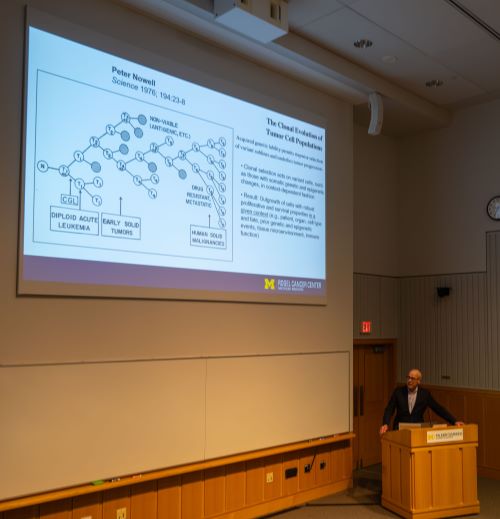 Dr. Eric Fearon, Emanuel N. Maisel Professor of Oncology, Director of the Rogel Cancer Center, Associate Dean for Cancer Programs, and Professor of Internal Medicine, then took the stage. His research focuses on Wnt/beta-catenin/TCF, CDX2, p53, and E-cadherin pathways in normal and neoplastic tissues. His talk focused on reviewing the history of our understanding of cancer pathogenesis, beginning with Peter Nowell’s 1960 discovery of the variant cell in chronic myeloid leukemia, BCR-ABL, and progressing to the current day. He encouraged students to challenge dogma, examine the data closely, and consider the context in which it is found. Important discoveries can be made when you think critically about research.
Dr. Eric Fearon, Emanuel N. Maisel Professor of Oncology, Director of the Rogel Cancer Center, Associate Dean for Cancer Programs, and Professor of Internal Medicine, then took the stage. His research focuses on Wnt/beta-catenin/TCF, CDX2, p53, and E-cadherin pathways in normal and neoplastic tissues. His talk focused on reviewing the history of our understanding of cancer pathogenesis, beginning with Peter Nowell’s 1960 discovery of the variant cell in chronic myeloid leukemia, BCR-ABL, and progressing to the current day. He encouraged students to challenge dogma, examine the data closely, and consider the context in which it is found. Important discoveries can be made when you think critically about research.
 Franchesca Franzen, a fourth-year MCP student mentored by Dr. Andrew Muntean, then took the podium. Her research investigates the mechanistic differences between ENL and AF9 in MLL-ENL and MLL-AF9 leukemia. She is simultaneously pursuing a master’s in bioinformatics and is in the Translational Research Education Certification Program. Franzen’s talk, “Investigating the Function of ENL and AF9 Domains in MLL-r Leukemias” highlighted the molecular mechanisms driving hematologic malignancies.
Franchesca Franzen, a fourth-year MCP student mentored by Dr. Andrew Muntean, then took the podium. Her research investigates the mechanistic differences between ENL and AF9 in MLL-ENL and MLL-AF9 leukemia. She is simultaneously pursuing a master’s in bioinformatics and is in the Translational Research Education Certification Program. Franzen’s talk, “Investigating the Function of ENL and AF9 Domains in MLL-r Leukemias” highlighted the molecular mechanisms driving hematologic malignancies.
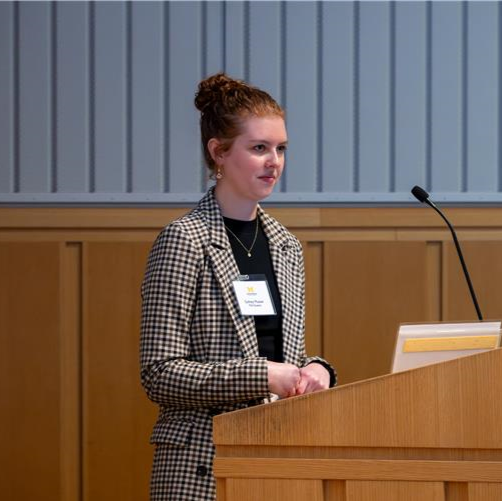 Sydney Musser, who is in the Drs.Tomasz Cierpicki and Jolanta Grembecka lab continued the focus on hematologic malignancies. Also a fourth-year MCP student, Musser presented her research, which investigates the cellular and molecular mechanisms of Polycomb repressive complex 1 inhibition in B-cell acute lymphoblastic leukemias. In addition to her research, Musser is the president of the Biomedical Graduate Student Government, representing all OGPS-affiliated graduate students, including the 14 PIBS PhD programs and the MSTP program.
Sydney Musser, who is in the Drs.Tomasz Cierpicki and Jolanta Grembecka lab continued the focus on hematologic malignancies. Also a fourth-year MCP student, Musser presented her research, which investigates the cellular and molecular mechanisms of Polycomb repressive complex 1 inhibition in B-cell acute lymphoblastic leukemias. In addition to her research, Musser is the president of the Biomedical Graduate Student Government, representing all OGPS-affiliated graduate students, including the 14 PIBS PhD programs and the MSTP program.
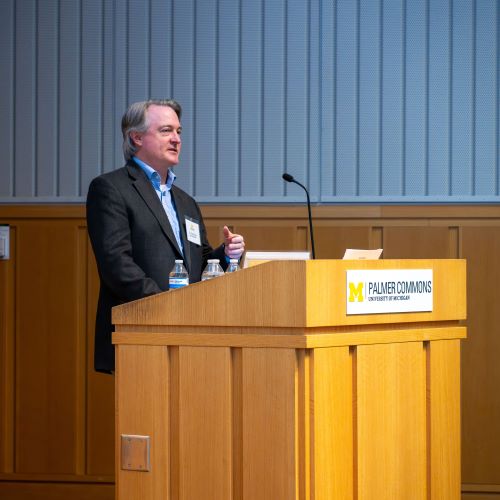 At 11:00 am, keynote speaker, Dr. Frank Slack, was introduced. Slack is the Shields Warren Mallinckrodt Professor of Pathology at Harvard Medical School and Director of the Harvard Medical School Initiative for RNA Medicine, based at the Beth Israel Deaconess Medical Center. He completed his postdoctoral training in Gary Ruvkun’s laboratory at Harvard, where his work contributed to Ruvkun’s 2024 Nobel Prize in Physiology or Medicine for discoveries involving microRNAs. Slack’s work has been foundational in revealing how microRNAs regulate key human oncogenes and how they can be harnessed as potential therapeutics in cancer. He also demonstrated the first role for microRNA in the aging process, and his ongoing work continues to expand our understanding of how RNA biology can be leveraged for innovative treatment strategies. His talk, “Towards MicroRNA Therapeutics in Cancer,” discussed what microRNAs are and their role in downregulating gene expression and regulating various biological processes, including cell differentiation, cell fate, motility, survival, and function. He discussed his research using C. elegans to better understand the role of microRNAs. Since each microRNA can have thousands of targets, specificity is the problem with using them for therapeutics. They are useful in multigenomic targets, where a single drug could affect multiple disease processes. Today, research into microRNA vaccines is expanding rapidly, with 1,355 clinical trials underway, as registered on ClinicalTrials.gov. In Singapore, they are being used as diagnostic biomarkers for lung cancer, gastrointestinal cancers, and in blood tests. They are very stable in fluids and escape digestion. He went on to discuss multiple experiments using microRNAs, which show great promise for future therapies.
At 11:00 am, keynote speaker, Dr. Frank Slack, was introduced. Slack is the Shields Warren Mallinckrodt Professor of Pathology at Harvard Medical School and Director of the Harvard Medical School Initiative for RNA Medicine, based at the Beth Israel Deaconess Medical Center. He completed his postdoctoral training in Gary Ruvkun’s laboratory at Harvard, where his work contributed to Ruvkun’s 2024 Nobel Prize in Physiology or Medicine for discoveries involving microRNAs. Slack’s work has been foundational in revealing how microRNAs regulate key human oncogenes and how they can be harnessed as potential therapeutics in cancer. He also demonstrated the first role for microRNA in the aging process, and his ongoing work continues to expand our understanding of how RNA biology can be leveraged for innovative treatment strategies. His talk, “Towards MicroRNA Therapeutics in Cancer,” discussed what microRNAs are and their role in downregulating gene expression and regulating various biological processes, including cell differentiation, cell fate, motility, survival, and function. He discussed his research using C. elegans to better understand the role of microRNAs. Since each microRNA can have thousands of targets, specificity is the problem with using them for therapeutics. They are useful in multigenomic targets, where a single drug could affect multiple disease processes. Today, research into microRNA vaccines is expanding rapidly, with 1,355 clinical trials underway, as registered on ClinicalTrials.gov. In Singapore, they are being used as diagnostic biomarkers for lung cancer, gastrointestinal cancers, and in blood tests. They are very stable in fluids and escape digestion. He went on to discuss multiple experiments using microRNAs, which show great promise for future therapies.
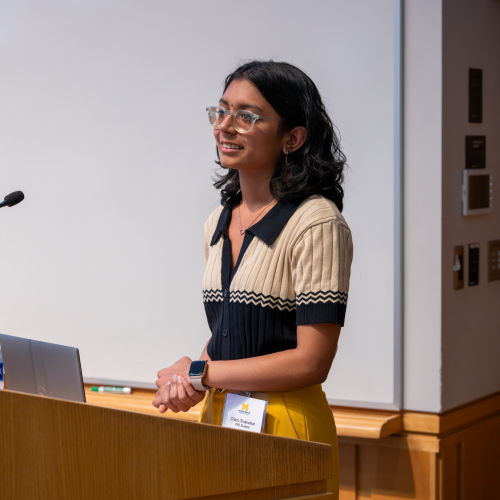 Following a lunch break, Thandiwe-Kesi Robins and Neil Zhao, two more third-year graduate students, assumed the role of moderators and hosted the afternoon’s speakers. The first afternoon speaker, Charukesi Sivakumar, a fourth-year MCP student in Dr. Rajesh Rao’s laboratory, was introduced and presented her talk on the role of KAT8/MOF in retinal development and disease. Sivakumar is the MCP Student Council president and the communications director for Michigan Science Writers. In the Rao lab, she studies the role of epigenetic mechanisms during retinal development and disease, using mouse pluripotent stem cell-derived retinal organoids to better understand the mechanisms of retinal development.
Following a lunch break, Thandiwe-Kesi Robins and Neil Zhao, two more third-year graduate students, assumed the role of moderators and hosted the afternoon’s speakers. The first afternoon speaker, Charukesi Sivakumar, a fourth-year MCP student in Dr. Rajesh Rao’s laboratory, was introduced and presented her talk on the role of KAT8/MOF in retinal development and disease. Sivakumar is the MCP Student Council president and the communications director for Michigan Science Writers. In the Rao lab, she studies the role of epigenetic mechanisms during retinal development and disease, using mouse pluripotent stem cell-derived retinal organoids to better understand the mechanisms of retinal development.
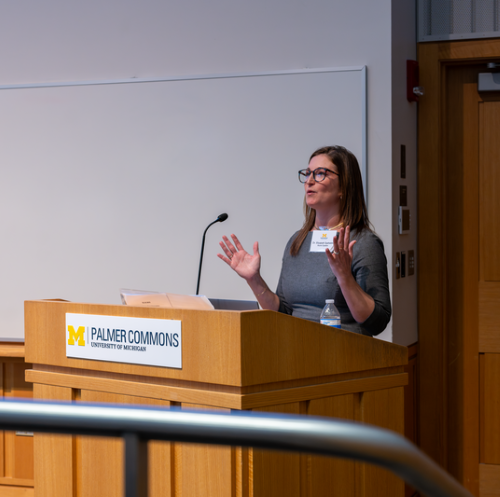 Alumni speaker, Dr. Elizabeth Spehalski followed. She graduated from the MCP program in 2013 in the laboratory of the late Dr. David Ferguson. Her dissertation, “Regulation of DNA Repair and Recombination by Mre11 and Cis-Acting Elements in B-Lymphocytes,” resulted in an impressive three first-author publications in high-impact journals, including Nature Structural & Molecular Biology, PNAS, and Cancer Research. Spehalski spent six years at the FDA, reviewing pharmacology and toxicology studies for IND, NDA, and BLA applications in the Center for Drug Evaluation and Research, Division of Hematology, Oncology, and Toxicology. She then took a position as a Principal Consultant in Regulatory Strategy, Nonclinical, at Parexel, where she advises clients on nonclinical development programs for drugs, biologics, and cell and gene therapy products to enable clinical trials or gain FDA approvals. In her presentation, Spehalski discussed “Drug Review at the FDA: How your research fits into FDA approval of new therapies.” She discussed the structure of the FDA and the various types of applications, as well as their corresponding timelines for approval. Pre-IND review takes 60-75 days, IND review takes 30 days, NDA/BLA reviews take about 8 months. She also advised students who may be interested in working for the FDA to focus heavily on writing skills and the ability to effectively review manuscripts. To work for the FDA, students will also need a minimum of a one-year postdoctoral fellowship. In addition, the FDA is now making heavy use of internal AI systems, so understanding how AI works will be important.
Alumni speaker, Dr. Elizabeth Spehalski followed. She graduated from the MCP program in 2013 in the laboratory of the late Dr. David Ferguson. Her dissertation, “Regulation of DNA Repair and Recombination by Mre11 and Cis-Acting Elements in B-Lymphocytes,” resulted in an impressive three first-author publications in high-impact journals, including Nature Structural & Molecular Biology, PNAS, and Cancer Research. Spehalski spent six years at the FDA, reviewing pharmacology and toxicology studies for IND, NDA, and BLA applications in the Center for Drug Evaluation and Research, Division of Hematology, Oncology, and Toxicology. She then took a position as a Principal Consultant in Regulatory Strategy, Nonclinical, at Parexel, where she advises clients on nonclinical development programs for drugs, biologics, and cell and gene therapy products to enable clinical trials or gain FDA approvals. In her presentation, Spehalski discussed “Drug Review at the FDA: How your research fits into FDA approval of new therapies.” She discussed the structure of the FDA and the various types of applications, as well as their corresponding timelines for approval. Pre-IND review takes 60-75 days, IND review takes 30 days, NDA/BLA reviews take about 8 months. She also advised students who may be interested in working for the FDA to focus heavily on writing skills and the ability to effectively review manuscripts. To work for the FDA, students will also need a minimum of a one-year postdoctoral fellowship. In addition, the FDA is now making heavy use of internal AI systems, so understanding how AI works will be important.
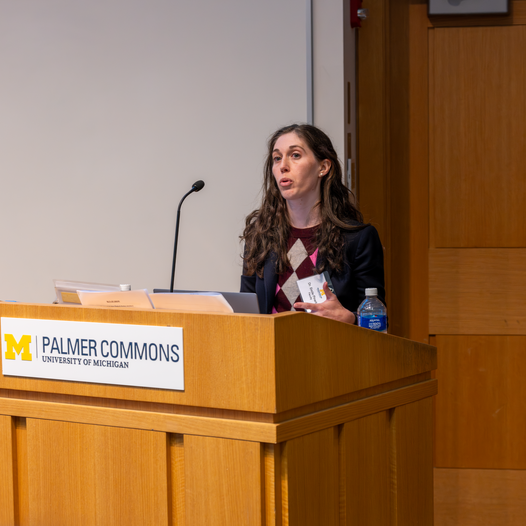 Clinical instructor in neuropathology and postdoctoral fellow in the Barmada Lab, Emile Pinarbasi, MD, PhD, was the next speaker on the docket. Pinarbasi was an MSTP student at the University of Texas Southwestern in the lab of Dr. Philip Thomas where her thesis studies focused on the intracellular trafficking of TDP-43. She then came to the University of Michigan for her clinical training, completing a residency in anatomic pathology and a fellowship in neuropathology. Pinarbasi gave an intriguing talk “When TDP-43 shows up LATE.” LATE is limbic predominant age-related TDP-43 Encephalopathy. This is found as a comorbidity in 50% of Alzheimer's disease patients. Alzheimer’s disease patients have Tau bodies with NFT folds, Pick’s disease has a Pick body fold, but the Tau folding structure in LATE was unknown. Pinarbasi’s research uncovered a hockey-stick shaped TAU in LATE, similar to that found in chronic traumatic encephalopathy, however, no CTE pathology was found. Her research is ongoing.
Clinical instructor in neuropathology and postdoctoral fellow in the Barmada Lab, Emile Pinarbasi, MD, PhD, was the next speaker on the docket. Pinarbasi was an MSTP student at the University of Texas Southwestern in the lab of Dr. Philip Thomas where her thesis studies focused on the intracellular trafficking of TDP-43. She then came to the University of Michigan for her clinical training, completing a residency in anatomic pathology and a fellowship in neuropathology. Pinarbasi gave an intriguing talk “When TDP-43 shows up LATE.” LATE is limbic predominant age-related TDP-43 Encephalopathy. This is found as a comorbidity in 50% of Alzheimer's disease patients. Alzheimer’s disease patients have Tau bodies with NFT folds, Pick’s disease has a Pick body fold, but the Tau folding structure in LATE was unknown. Pinarbasi’s research uncovered a hockey-stick shaped TAU in LATE, similar to that found in chronic traumatic encephalopathy, however, no CTE pathology was found. Her research is ongoing.
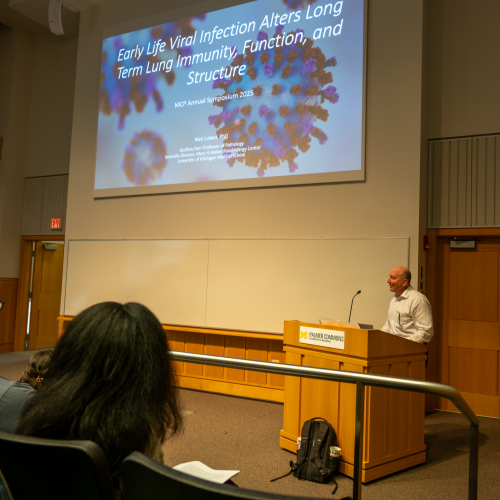 The final speaker of the day, Dr. Nicholas Lukacs, is the Godfrey D. Stobbe Professor of Pathology at the University of Michigan Medical School. He joined the department in 1994. His lab investigates the innate and acquired immune responses in allergen- and respiratory-virus-induced acute and chronic diseases, as well as the impact of the gut microbiome on the development of allergic disease. In his lab, he examines dendritic cell and T-cell function, epigenetic modulation of immune and pathologic responses, and collaborative translational studies in severe respiratory syncytial virus (RSV) infections in infants and food and airborne allergen responses in urban birth cohorts, integrating human and animal models. In his talk, “Early life viral infection alters immune responses and lung function long term,” Lukacs discussed how early diagnosis with RSV leads to changes in the alveolar lung structure. This causes long-term lung damage and increased incidence of asthma, COPD, and other obstructive breathing issues. This increases the risk of premature death two-fold.
The final speaker of the day, Dr. Nicholas Lukacs, is the Godfrey D. Stobbe Professor of Pathology at the University of Michigan Medical School. He joined the department in 1994. His lab investigates the innate and acquired immune responses in allergen- and respiratory-virus-induced acute and chronic diseases, as well as the impact of the gut microbiome on the development of allergic disease. In his lab, he examines dendritic cell and T-cell function, epigenetic modulation of immune and pathologic responses, and collaborative translational studies in severe respiratory syncytial virus (RSV) infections in infants and food and airborne allergen responses in urban birth cohorts, integrating human and animal models. In his talk, “Early life viral infection alters immune responses and lung function long term,” Lukacs discussed how early diagnosis with RSV leads to changes in the alveolar lung structure. This causes long-term lung damage and increased incidence of asthma, COPD, and other obstructive breathing issues. This increases the risk of premature death two-fold.
As the day concluded, award winners were announced:
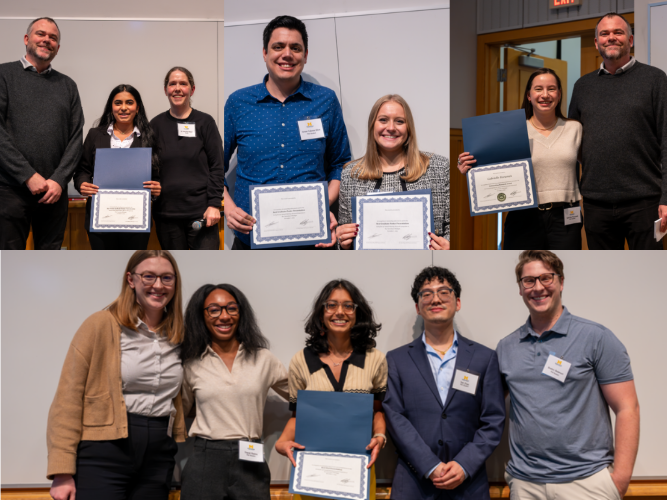 Best Undergraduate Student Poster: Aashi Shah (Mentors: Janakraj Bhattrai and Ursula Jakob) “Transient changes in H3K4me3 and its effect on longevity of C. elegans.”
Best Undergraduate Student Poster: Aashi Shah (Mentors: Janakraj Bhattrai and Ursula Jakob) “Transient changes in H3K4me3 and its effect on longevity of C. elegans.”
Best Graduate Student Poster: Rodolfo Ismael Cabrera Silva (Mentors: Asma Nusrat and Charles Parkos) “RUNX2 promotes epigenetic WNT signaling in inflamed intestinal epithelial cells.”
Best Graduate Student Poster: Grace McIntyre (Mentor: Analisa DiFeo) “Therapeutic inhibition of oncogenic miR-181a processing for cancer therapy.”
Best Research Fellow Poster: Somnath Mahapatra (Mentors: Rahul Mannan and Arul Chinnaiyan) “Comprehensive evaluation of RNA integrity for 10x Genomics Visium HD Spatial Transcriptomics using novel RNA in-situ hybridization technology for quality control purposes.”
Best Oral Presentation: Charukesi Sivakumar (Mentor: Rajesh Rao) for her talk, “Elucidating the role of KAT8/MOF in Retinal Development and Disease.”
MCP Outstanding Research Award: Gabrielle Rozumek (Mentor: Lev Prasov) for her research on MYRF and its impact on nanophthalmos.
MCP Outstanding Service Award: Koral Campbell (Mentors: Qing Li and Andrew Muntean)
The MCP Outstanding Service Award recognizes a student who has shown great commitment of time and effort towards service to the department and the community at an institutional, local, national and/or international level. Koral is passionate about science education and has been involved in the following organizations:
-Developing Future Biologists Instructor. This program develops, hosts, and teaches a short course in developmental biology for undergraduate students from underrepresented communities without access to STEM education and opportunities.
-Food Gatherers at the Delonis Center. She volunteers preparing and serving food for individuals experiencing homelessness
-Letters to Pre-Scientists (LPS)
-SEEK, an outreach program teaching basic sciences to elementary school students in underprivileged schools.
A special thanks was also given to Laura Labut, who provided behind-the-scenes support for all the graduate students as they planned and hosted the symposium. This concluded the 24th Annual Pathology Research Symposium, highlighting our exceptional graduate students and the vital work they do each and every day. For more information on our graduate program, please visit our website.
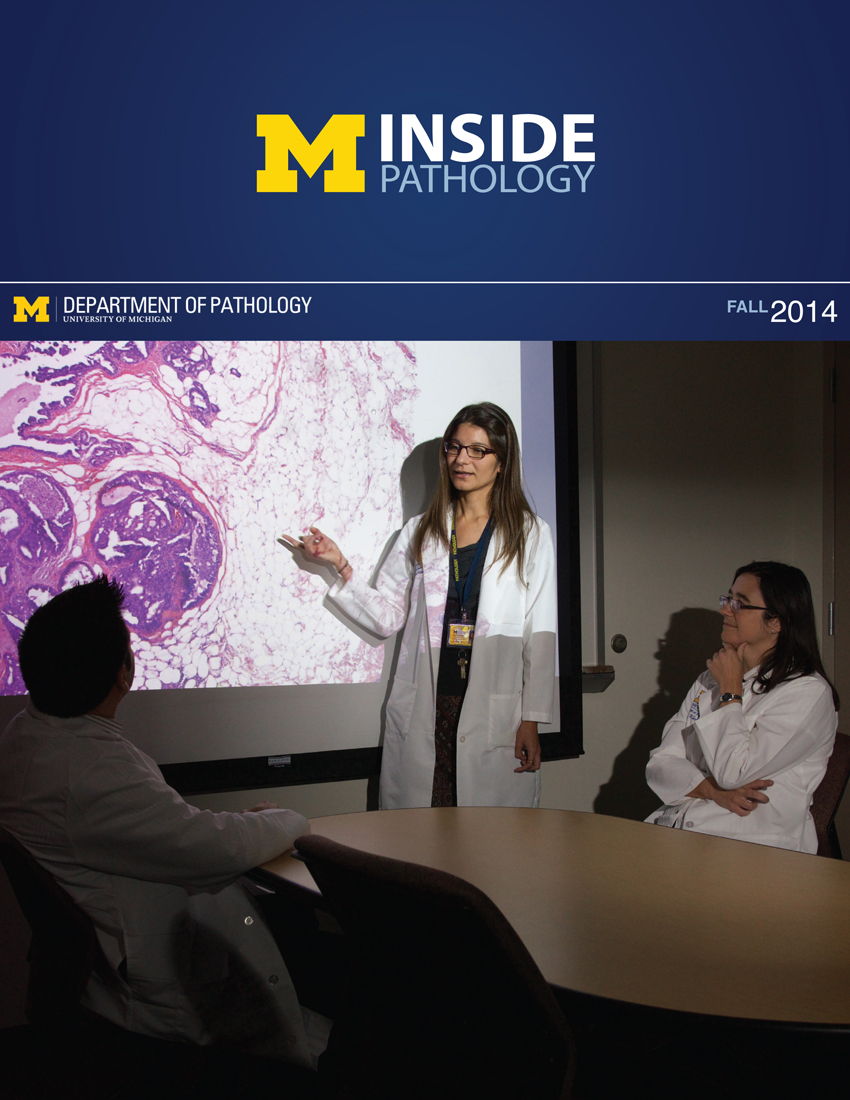 ON THE COVER
ON THE COVER
 ON THE COVER
ON THE COVER
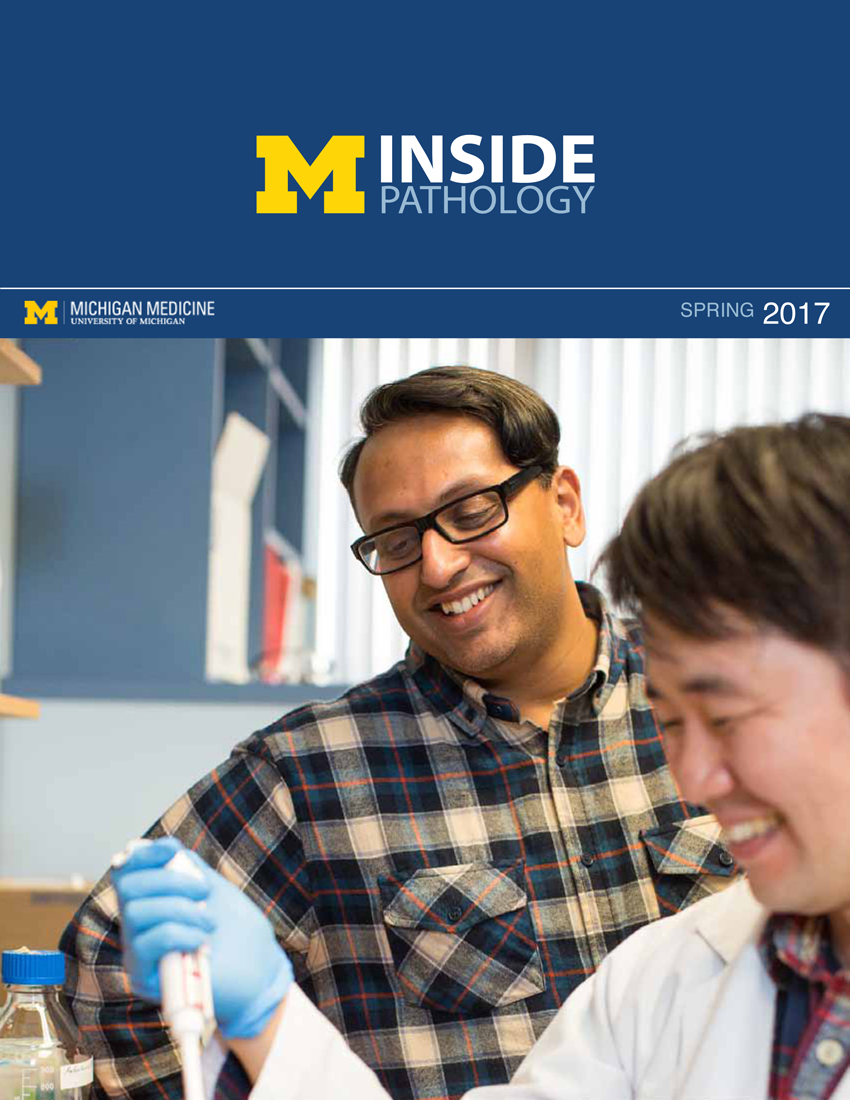 ON THE COVER
ON THE COVER
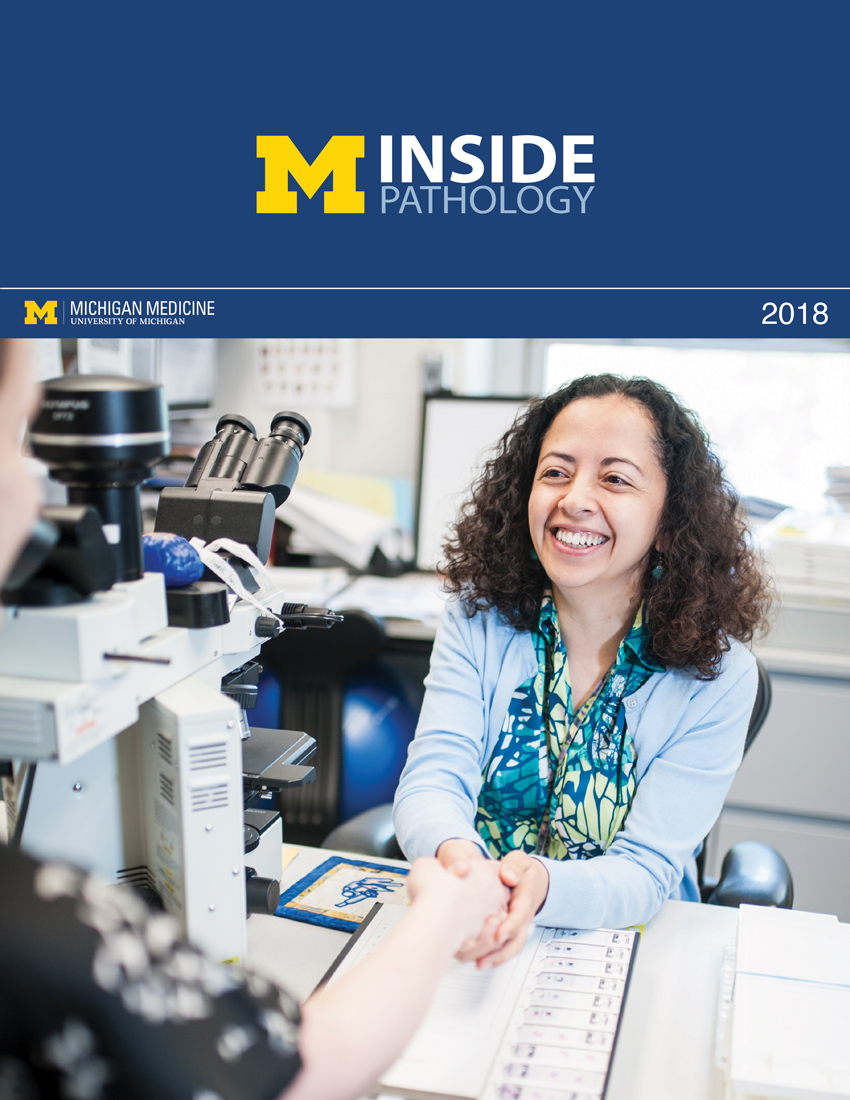 ON THE COVER
ON THE COVER
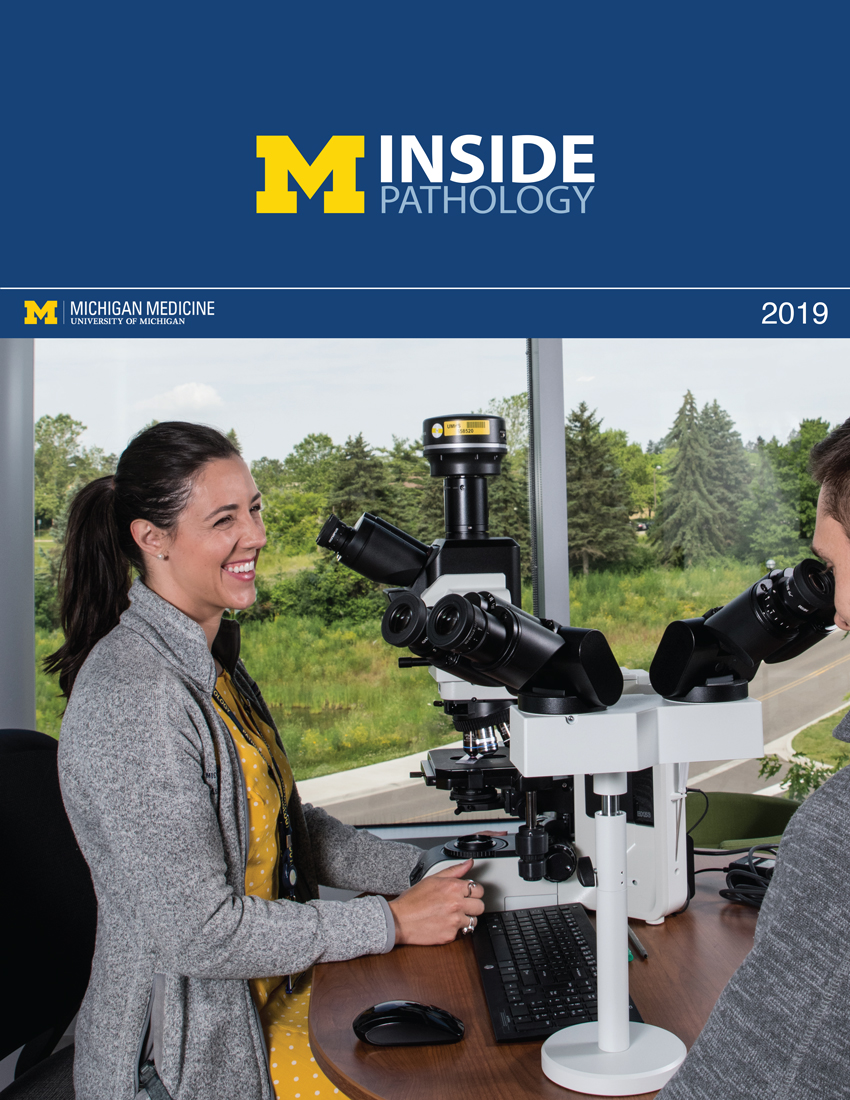 ON THE COVER
ON THE COVER
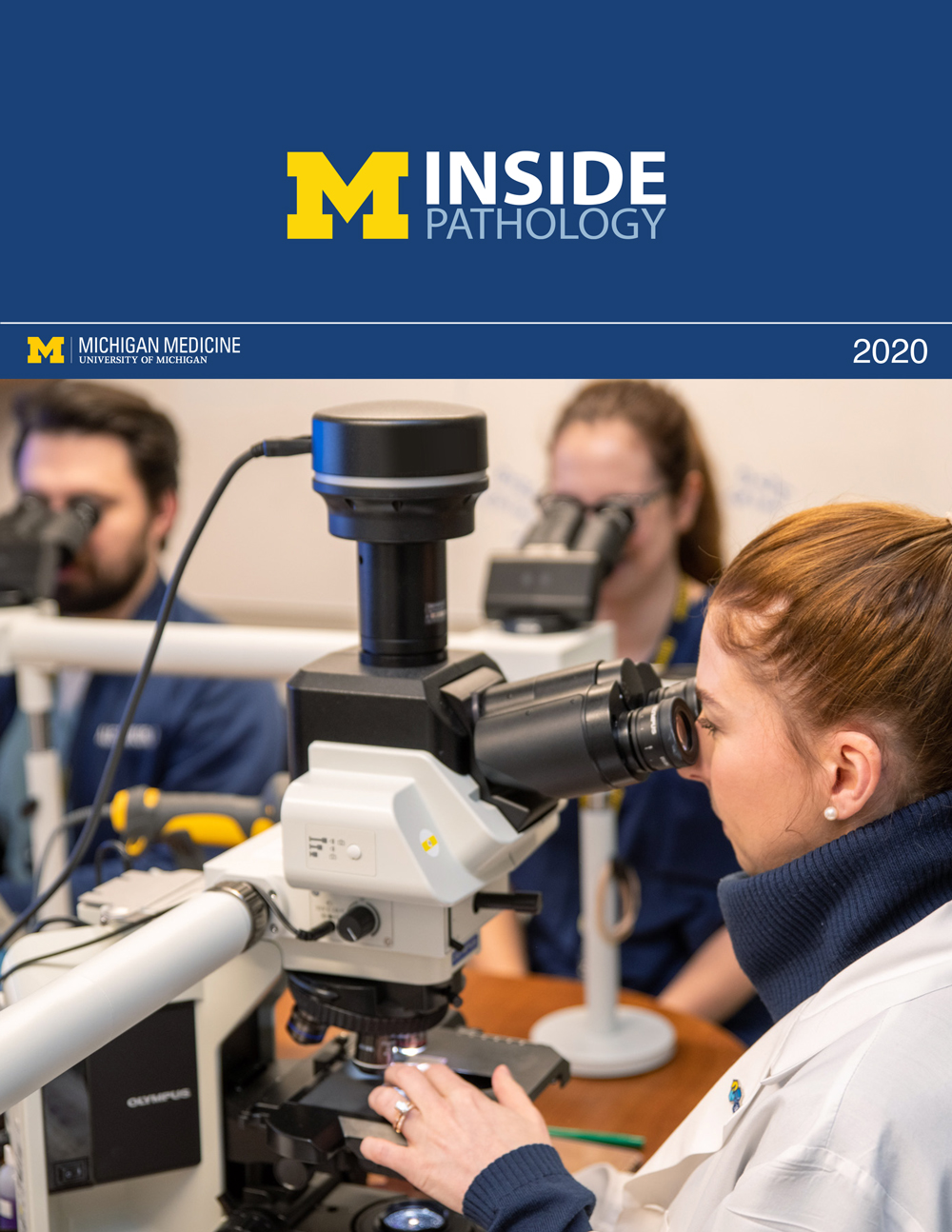 ON THE COVER
ON THE COVER
 ON THE COVER
ON THE COVER
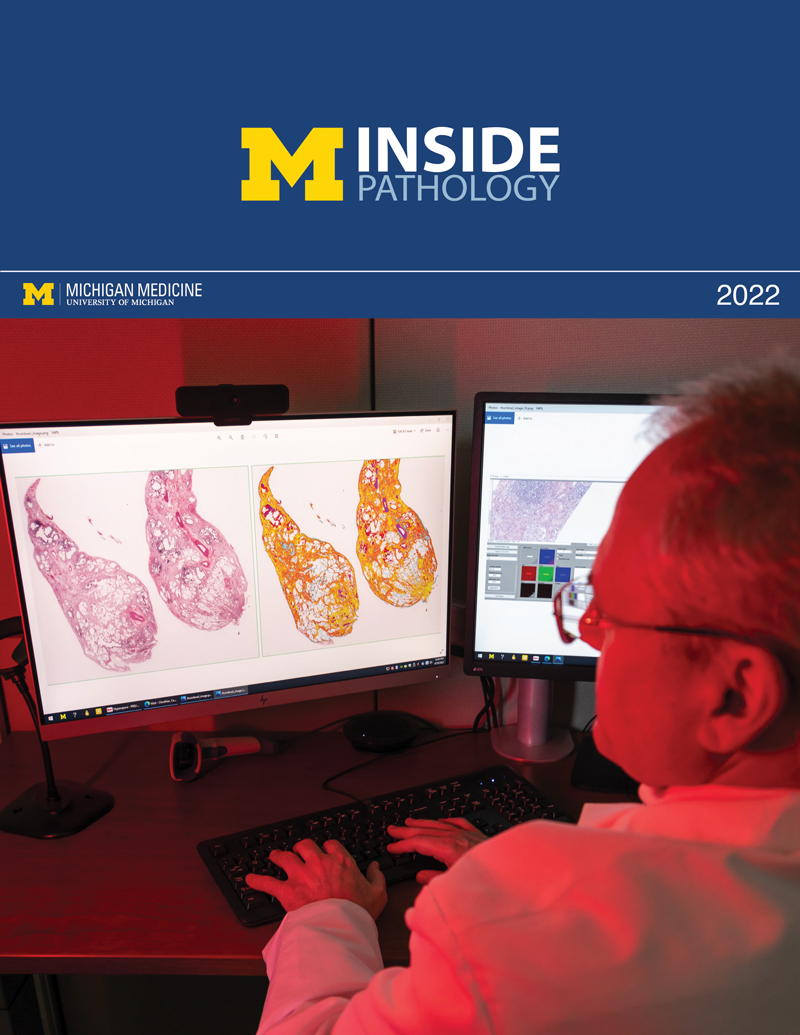 ON THE COVER
ON THE COVER
 ON THE COVER
ON THE COVER
 ON THE COVER
ON THE COVER
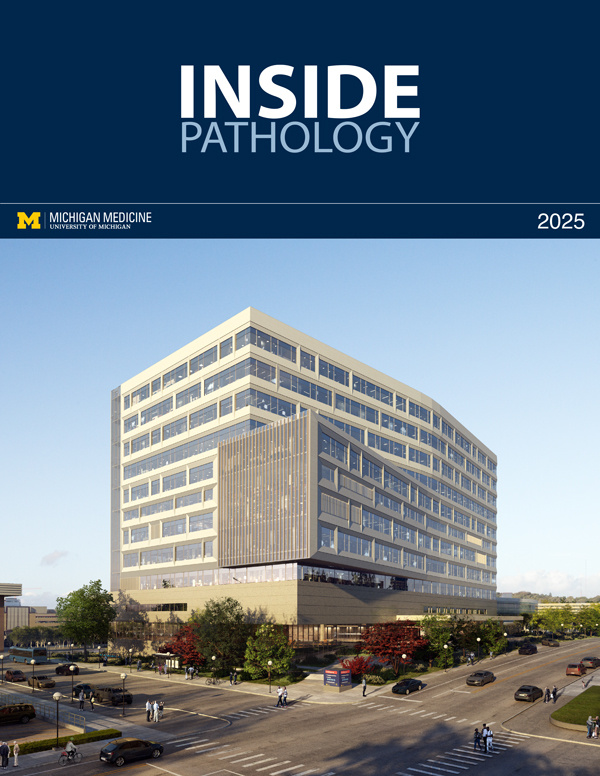 ON THE COVER
ON THE COVER
